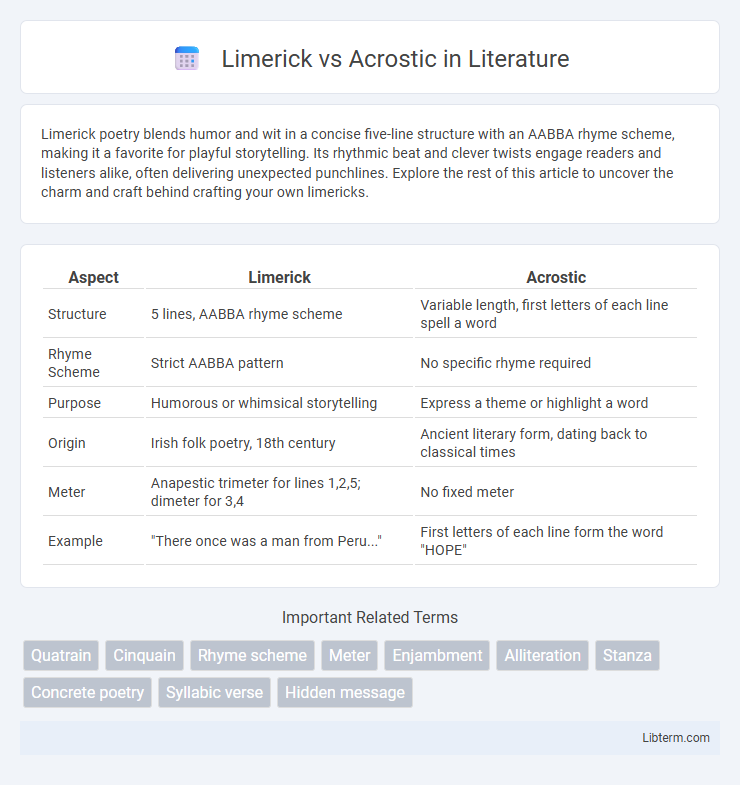Limerick poetry blends humor and wit in a concise five-line structure with an AABBA rhyme scheme, making it a favorite for playful storytelling. Its rhythmic beat and clever twists engage readers and listeners alike, often delivering unexpected punchlines. Explore the rest of this article to uncover the charm and craft behind crafting your own limericks.
Table of Comparison
| Aspect | Limerick | Acrostic |
|---|---|---|
| Structure | 5 lines, AABBA rhyme scheme | Variable length, first letters of each line spell a word |
| Rhyme Scheme | Strict AABBA pattern | No specific rhyme required |
| Purpose | Humorous or whimsical storytelling | Express a theme or highlight a word |
| Origin | Irish folk poetry, 18th century | Ancient literary form, dating back to classical times |
| Meter | Anapestic trimeter for lines 1,2,5; dimeter for 3,4 | No fixed meter |
| Example | "There once was a man from Peru..." | First letters of each line form the word "HOPE" |
Introduction to Limerick and Acrostic Poetry
Limerick poetry is known for its distinct five-line structure with an AABBA rhyme scheme, often incorporating humor and rhythmic beats. Acrostic poetry arranges the first letters of each line to spell out a word or message, emphasizing form and thematic coherence. Both styles offer unique creative constraints that challenge poets to convey meaning through structured patterns.
Defining Limerick: Structure and Features
A limerick is a five-line poem with a strict AABBA rhyme scheme and a specific meter, typically anapestic trimeter for lines 1, 2, and 5, and anapestic dimeter for lines 3 and 4. It features a humorous or whimsical tone, often with a punchline or twist in the final line. The distinct rhythmic pattern and rhyme scheme make limericks easily recognizable and memorable compared to other poetic forms like acrostics.
Defining Acrostic: Structure and Features
An acrostic is a poetic form where the first letter of each line spells out a word or message vertically, often revealing the poem's theme. Its structure is flexible in line length and meter, emphasizing the hidden word rather than strict rhyme schemes. This feature differentiates acrostics from limericks, which follow a rigid five-line, anapestic meter with an AABBA rhyme pattern.
Historical Origins of Limerick and Acrostic Forms
The limerick originated in the early 18th century, gaining popularity through the works of Edward Lear, characterized by its five-line structure and AABBA rhyme scheme rooted in Irish oral tradition. Acrostic poetry dates back to ancient times, with examples found in classical Greek and Latin literature, using the initial letters of each line or stanza to spell out words or messages, often serving mnemonic or devotional purposes. Both forms showcase the evolution of poetic expression through historical contexts emphasizing structure and meaning.
Differences in Rules and Composition
Limericks consist of five lines with a strict AABBA rhyme scheme and a specific rhythm pattern, typically anapestic meter with three metrical feet in lines one, two, and five, and two feet in lines three and four. Acrostic poems, by contrast, are structured around the initial letters of each line, which spell out a word or message vertically, without a mandated rhyme scheme or meter. The primary distinction lies in the limerick's fixed rhyme and rhythm rules versus the acrostic's focus on letter placement as a compositional constraint.
Popular Themes in Limerick vs Acrostic Poems
Limericks commonly explore humorous, whimsical, or absurd themes, often featuring playful characters or witty scenarios that evoke laughter. Acrostic poems typically focus on personal subjects such as names, emotions, or inspiring concepts, with each line's initial letter spelling out a word or phrase central to the theme. The distinct thematic tendencies highlight limericks' lighthearted storytelling and acrostics' expressive, often sentimental, wordplay.
Famous Examples of Limerick and Acrostic Poems
Edward Lear's "The Owl and the Pussycat" remains a quintessential example of a limerick, showcasing its whimsical and rhythmic style through five lines with an AABBA rhyme scheme. Acrostic poems like Edgar Allan Poe's "An Acrostic," where the first letter of each line spells out a word or message, highlight the creative interplay between form and content. Both styles boast famous examples that emphasize playful word arrangement, with limericks focusing on humor and brevity, and acrostics often emphasizing hidden meanings or dedications.
When to Choose Limerick over Acrostic
Choose a Limerick over an Acrostic when aiming to deliver humor or wit through a concise, five-line poem with a strict AABBA rhyme scheme. Limericks excel in storytelling and playful tones, making them ideal for entertaining audiences or lighthearted themes. In contrast, Acrostics suit situations where highlighting specific words or concepts vertically enhances the message's clarity or emphasis.
Creative Tips for Writing Limerick and Acrostic
Exploring creative tips for writing limericks involves focusing on the classic AABBA rhyme scheme, ensuring humor or wit shines through concise five-line verses with a rhythmic meter. Crafting acrostics benefits from selecting meaningful words or themes that align vertically with each letter, allowing for both poetic expression and clever wordplay. Emphasizing vivid imagery and emotional resonance enhances the impact of both limericks and acrostics, making them memorable and engaging.
Conclusion: Limerick vs Acrostic—Which Suits Your Style?
Limericks deliver playful, rhythmic humor with a fixed AABBA rhyme scheme, ideal for lighthearted and entertaining poetry. Acrostics offer creative flexibility by incorporating thematic words spelled vertically, making them perfect for personalized messages or educational purposes. Choose limericks for structured wit and acrostics for creative expression tailored to conveying specific concepts or names.
Limerick Infographic

 libterm.com
libterm.com